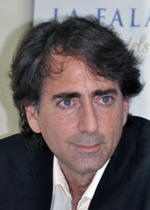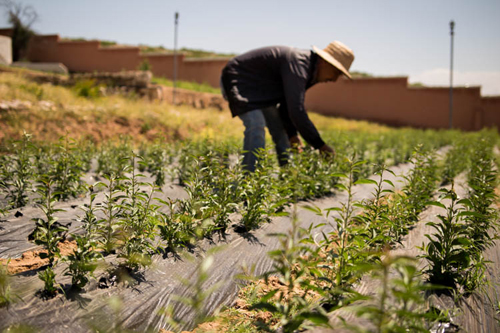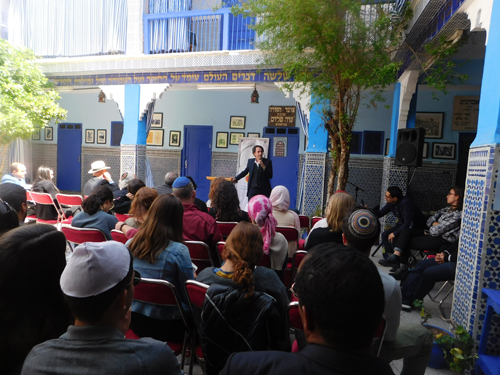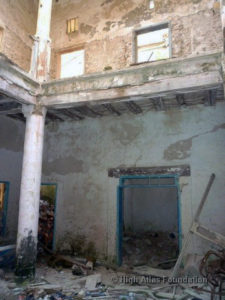By Dr. Yossef Ben-Meir
 MARRAKECH, Morocco — In the Kingdom of Morocco, there are a number of sustainable development programs and policies that display innovation and promote social solidarity. These participatory democratic initiatives are designed to catalyze people’s development that meet multiple human needs at the same time.
MARRAKECH, Morocco — In the Kingdom of Morocco, there are a number of sustainable development programs and policies that display innovation and promote social solidarity. These participatory democratic initiatives are designed to catalyze people’s development that meet multiple human needs at the same time.
For example, the Municipal Charter of the nation requires the application of participatory methods for inclusive planning of community projects. Doing so enables new enterprises to address economic, environmental, and social factors and goals in a given region. Another example is Morocco’s Decentralization Roadmap, which in its design harnesses the resources of the national and regional levels in order to achieve locally-identified development priorities.
And, an embodiment of Morocco’s integrated development approach is its chosen way to preserve its culture. According to statements and the vision of His Majesty King Mohammed VI, multicultural actions should directly lead to human development results.
This is to say that preserving Moroccan cultural institutions, locations, and artifacts, also intends at the same time to enhance the lives of people in measurable ways, such as in education, income, and health. In essence, cultural activities are to be advanced simultaneously together with people’s development.
Since early in his reign, the King of Morocco has championed the premise of integrating cultural and sustainable development into single movements. The kingdom’s position in regards to the Alliance of Civilizations, for example, embodies the natural chemistry of actions that are both multicultural and developmental, as well as – in the case of the Alliance – meant to improve cooperation among nations. As King Mohammed VI explained in 2008: “That vision consists in making sure culture serves as a driving force for development as well as a bridge for dialogue.”
Moroccan-Jewish cemetery rehabilitation
One clear example that is occurring within Morocco (where cultural preservation and advancing the well-being of people work congruently) is regarding the national project launched in 2012 to rehabilitate the Jewish cemeteries. There are approximately 600 Hebrew “saints” that are buried in all parts of the kingdom. Many have laid in rest a millennium or more, and 167 of the sites have been part of the national preservation effort.
Importantly, the Jewish community (starting in Marrakech) also began in 2012 to lend land to the High Atlas Foundation, a U.S.-Moroccan nonprofit organization, nearby seven of the sacred burials in order to plant organic fruit tree nurseries for the benefit of farming families and schools. Initial local efforts to preserve the Jewish cemeteries and lend land for community tree nurseries began in the 1990s, and has since been building to scale.
Given that most poverty in the nation (and in the world) exists in rural places, and that Moroccan farmers are transitioning from traditionally growing barley and corn, the demand for more profitable fruit trees is therefore very significant.

Growing fruit trees from seedlings on land lent by the Moroccan Jewry and distributing them in-kind to marginalized rural communities not only meets a development priority, but is also an act of interfaith. The reinvigorated relationships between the Muslim farming families and Jewish community members leads to deepened appreciation among the beneficiaries of these historic religious places (even as the burial sites have been respected ever since their beginning). This multicultural initiative lends towards more goodwill due to the sustainable development results, and in turn increased social unity and actions of preservation. What maximizes the measure of solidarity (and sustainability), however, is that the farming communities themselves identified fruit trees and their varieties as a development priority. Therefore, the project responds to the expressed needs of the people and helps to deliver the outcomes they seek, illustrating how cultural benefits can be maximized when participatory human development is fully incorporated into their processes.
The Marrakech mellah and Jewish continuity
Now, let’s consider the rehabilitation of the mellah, the Jewish quarter which historians suggest first appeared in Marrakech during the second half of the 16th century. The Jewish experience in Morocco, and certainly in Marrakech, with all of its cycles and periods, can be characterized as quite remarkable in its longevity and quality. There are impressive scholars who have dedicated themselves to understanding specifically and thematically what has transpired in Marrakech in regards to Jewish life, thought, cultural evolution, practice, trials, and major stretches of peaceful pluralism.
I personally have not given this level of consideration to the social developments that constitute the Jewish-Marrakech narrative. However, one can fairly state that Jewish life in Marrakech has been incredibly rich, complex, nonlinear, hopeful, painful, continuous, and ongoing to this very moment. Therefore, the initiative to preserve this living and evolving social artifact is exceptionally worthy, and an action fully consistent with the Moroccan national identity and Constitution.
I have often come up against this question of, why Morocco? Jewry had lived for millennia in Near Eastern nations, but no longer do; yet in Morocco they remain to this day, and are invited to return if they had left. When vandalism, violence, and rejection seems to characterize the Jewish experience to varying degrees at different times in many nations of the world, one might ask why this has not been the case in Morocco. This question on one level may be as difficult to answer as is the question of why the Jewish people continue to exist as a cohesive group in the world at all. Why Morocco is an ongoing home when other nations have ceased to be, could invite an esoteric explanation, or one simply accepting that observers have yet to fully explain Moroccan-Jewish exceptionalism.
One “mystical” explanation that accounts for the deep Moroccan-Jewish bond was given by the last Lubavitcher Rebbe, the most influential Jewish leader of the 20th century, the late Rabbi Menachem Schneerson (1902-1994). In messages conveyed between the Rebbe and the late His Majesty King Hassan II (1929-1999), the Rebbe had made positive statements regarding the continued security of the kingdom, and it as a home for Jewish people, on account of the Hebrew saints (referred to earlier) that are buried in its ground. In fact, it was precisely the presence of the buried saints that prompted the Rebbe to equate the holiness of the land of Morocco to that of Israel. These assertions of the Rebbe are according to my conversations (in 2016) with Serge Berdugo, the Secretary General of the Moroccan Jewish Community and the then interlocutor between the Rebbe and King Hassan II.
Two considerable, more social scientific factors that account for the Moroccan-Jewish experience are seemingly clear: the kings of Morocco have set a vision and historic outlook that is absolutely indispensable to Jewish continuity and the indelible connection that Moroccan Jews have to the country, even long after they have relocated elsewhere. Another noted example of this is the manner in which the late His Majesty King Mohammed V protected Moroccan Jews in the face of Nazi persecution during World War II – a display of statesmanship for the ages.
In addition, the Moroccan people and the ultimately accepting culture that has emerged from them, is a vital element which helps to explain the Moroccan-Jewish story. This is to say, the people and their monarchs have set the standard which has chartered the kind of life that allows Moroccan Jewry to endure until today. The mellah and its preservation is a “normal” outgrowth of the past and present. Again, the fact that Moroccan public and civil sectors recognize and continuously uphold this dimension of its culture is in itself ordinarily Moroccan.
Evaluating the mellah’s revitalization

In regards to the human development dimension of the Marrakech mellah’s rehabilitation, one can first begin by stating that the initiative clearly serves as a short-term economic stimulus by way of investing in the employment and materials necessary to design and reconstruct the area. Rebuilding infrastructure is a form of measurable human development. It is no wonder then that the residents of the mellah in general have positive outlooks on the initiative.
Taking a participatory development perspective, however, there are further questions to consider, such as: how many local residents and their associations were involved in the planning of the rehabilitation of their neighborhood? How many residents were involved in the prioritization of the sites to be refurbished? Did the residents have a voice in creating the new designs of public areas? Were the immediate residents informed and educated about the meaning of the Jewish-Hebrew names of old of the streets and the reasons they were brought back?

In the Moroccan coastal city, Essaouria, for example, the local associations were fully involved (again with the facilitation work of the High Atlas Foundation) in the selection of the specific historical-religious sites that require rehabilitation. Inclusive participation helped bring out the idea – as well as helped forge needed public-private partnerships – to enable the proposed renovation of the Portuguese church to provide space for civil society workshops, their offices, and a display area for their crafts and innovations. Here there is a link between cultural preservation and the ongoing advancement of human development, that would continue well after reconstruction ends.
Taking the proposed rehabilitation of Essaouria as a model and applying it to the renovation of the Marrakech mellah, we need to evaluate if the structures that have been brought back provide civil society space and continue to further sustainable development. Did rebuilding the mellah create a groundswell of community meetings where the local people participated in the planning and design of projects that meet their needs? Are we witnessing ongoing development transformation driven by heightened solidarity and new opportunity? Are there subsequent or indirect projects that will ripple on from people’s broad participation, thereby generating many times over the amount of the cultural preservation investment?
It is exceedingly difficult, but not impossible, to involve people’s participation in defining goals after the development process is deep into implementation. My understanding is that to date, the mellah has been a good economic and publicity stimulus, but the needed domino-effect of ongoing development carried on by the local residents and their civil organizations is substantially less than optimal. This is primarily due to the fact that their participation was not adequately enlisted from the start of the rehabilitation program.
However, there is a strong desire among local partners to facilitate people’s participation in the human development dimension of the mellah’s restoration. For example, during the upcoming holy month of Ramadan in the Islamic calendar (from May 26th through June 25th), the Marrakech Jewish community, the Association Mimouna of Moroccan Muslim students, with the High Atlas Foundation are organizing F’tor (the meal breaking the fast at sundown) for local residents each Monday and Thursday at the mellah’s 400-year-old Slat Lazama Synagogue. The meal will be followed by community discussion and determination of local people’s new primary socio-economic and environmental initiatives.
Finally, the case of the mellah reminds me of an observation that one often makes when assisting social development in Morocco over time: the kingdom offers powerful and exemplary models for sustainable and shared growth driven by the participatory method. Thankfully, the participatory approach is codified into laws, polices, and programs. On the other hand, however, it remains a serious challenge to effectively achieve broad-based implementation in close accordance with the participatory vision that has been set forth to guide such actions. This is primarily because the skills to organize and facilitate local collaborative planning are not well enough dispersed, and the system of centralized management is so well entrenched.
The nation is one of hope because of its past and present, its idealism, and commitment to sustainability. In a sense, though, Morocco’s challenge is confronted by all nations that are guided by practical ideals: to conscientiously embody act-by-act the progressive values that are intended to plot the course of their national development now and in the future.
Dr. Yossef Ben-Meir is a sociologist and president of the High Atlas Foundation, a non-government organization dedicated to sustainable development.